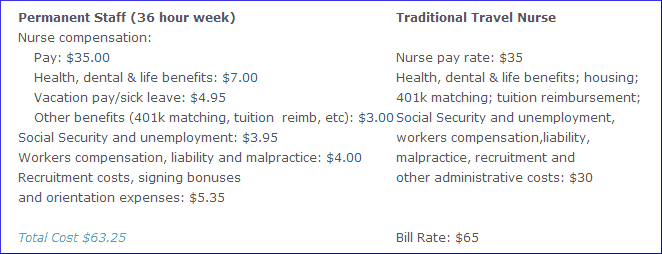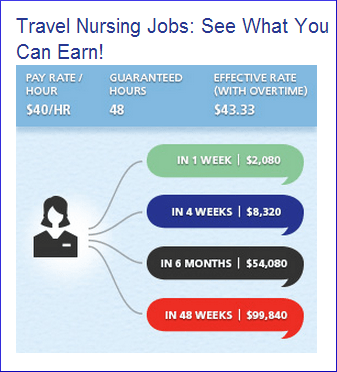5 Factors that Depress Travel Nursing Pay Rates
It’s no secret that travel nursing pay rates fluctuate. Of course, that means that travel nursing pay rates decrease sometimes. During those times, travel nurses understandably speculate about the cause. The reality is that there are many intermittent and constant variables that negatively affect pay rates. So, in this article, we’ll take a look at 5 factors that contribute to lower travel nursing pay rates.
General Supply and Demand Issues in the Travel Nursing Job Market
Like everything else in the economy, travel nursing is subject to the effects of supply and demand. At certain times, there are more jobs available than there are travel nurses to fill them. At other times, there are more travel nurses than jobs.
Economists call the job market “slack” when there are more workers than jobs. Slack job markets are almost always the result of a decrease in the number of available jobs. That said, it’s possible, albeit uncommon, for the number of workers to grow organically faster than the number of jobs.
Regardless of how it happens, a slack job market puts downward pressure on pay rates. Employers recognize the trend quickly when they get inundated with applicants seconds after posting a job. When this happens, they’ll reduce bill rates if they can. Pay rates will follow suit.
Travel Nurses Accepting Low Pay Rates
When this happens, many travel nurses urge their colleagues not to accept the lower pay rates. They argue if no one accepted the rates, then the rates would rise.
While this may be true, it’s all but impossible to expect travel nurses to abide. Travel nurses are distributed. Each an individual doing what they think is best. What’s low to one person might be just fine for another.
It’s also important to note that not all hospitals are able to reduce bill rates that quickly. Many hospitals have bill rates that are bound by contract until the contract ends. As a result, travel nursing pay packages can exhibit disparity.
So, a travel nurse can land both low and high paying contracts over the course of a year. Therefore, their annual pay can end up being just fine.
Ultimately, the market works this out on its own. Those who feel the rates are too low take permanent positions and some semblance of equilibrium returns to the market.
In any case, there are many other variables that put downward pressure on travel nursing pay rates. Many of these variables are constantly at play.
Travel nursing 2008-2016
First let’s take a quick look at what happened between 2008 and 2016 to provide some background. In 2008, Staffing Industry Analysts estimated that the travel nursing segment of the healthcare staffing industry generated $2.4 billion in revenue.
Decreased Demand
Then the financial crisis occurred. People put off medical treatments to save money. High unemployment meant fewer people with health coverage which resulted in lower patient populations. Many nurses who were expected to retire kept working, others picked up extra shifts.
The number of travel nursing jobs declined dramatically. Many travel nurses took full time positions for stability.
Increased Demand
In 2010, the healthcare staffing segment of the temporary staffing industry was the only segment to decline. Then, the market rose between 2010 and 2016.
We estimate that the number of travel nurses doubled during this period. It went from approximately 15K-20K to 40K-45K. That’s a massive increase. One would expect bill rates to rise significantly during that time given the “nursing shortage”.
Stagnant Bill Rates Despite Increased Demand
While agencies did report increased bill rates, the increases barely kept up with inflation. For example, Cross Country’s 10-Q filing from August 2013 cited a year over year increase in bill rates of 3%. American Mobile cited similar increases in their own 10-Ks and 10-Qs.
The largest increase we were able to find among SEC filings from 2008-2016 was 3% year over year. Meanwhile, annual inflation rates were between 1.5% and 3% between 2008 and 2016. So bill rates were barley keeping up with inflation.
And it would seem as though travel nursing pay rates did not fully benefit from even these modest gains. A closer look at these SEC filings indicated where the additional revenue from bill rate increases was going.
First, the increases were offsetting cost increases in factors such as housing and professional liability costs. Second, both companies cited improved “bill to pay spreads.” That’s a fancy way of saying that they’re getting higher gross profits.
Therefore, it stands to reason that travel nursing pay rates would have been stagnant, or perhaps even lower on a cost adjusted basis. It’s possible that this didn’t happen at EVERY agency, but it certainly happened at the largest agencies.
A Short-Lived Spike
All that said, bill rates seem to have spiked in 2015-2016. Both AMN and Cross Country mentioned increased crisis rates in their quarterly conference calls in 2016. Additionally, travel nursing companies appeared to be offering higher pay packages.
However, this seems to have leveled off by the middle of 2017. Given the way the market reacted during this period, logic dictates that there are other factors at play beyond simple supply/demand dynamics.
Again, supply/demand most certainly plays a role. However, the following industry specific issues all have a tendency to put downward pressure on pay. It’s important to note that we are not offering these issues in any specific order.
Vendor Management Services
In the healthcare staffing industry, Vendor Management Services are services that help hospitals manage their relationships with the agencies they work with. Simply put, by centralizing and formalizing all communication, processes and procedures, Vendor Management Services allow hospitals to work with as many agencies as they want. This increases competition between agencies.
And bill rates are one of the main issues that agencies compete on. For example, some Vendor Management Systems let agencies bid against one another on the bill rate for each job.
Managed Service Providers
Similarly, if a hospital is looking for a new Managed Service Provider, then you can rest assured that bill rates are one of the big selling points. For example, when AMN won the Kaiser contract in 2012, the bill rates were reduced by 10%-15% from what they previously were with Nursefinders.
Moreover, Vendor Management Services tout lower bill rates when selling their services to hospitals. They point out that rather than having multiple bill rates with various agencies, the hospital can have one standard bill rate. This is commonly referred to as “standardized rates.” This means that all nurses, regardless of experience, receive the same bill rate.
AMN’s quarterly report in November 2014 stated that the company continues to “see clients migrate to managed services program relationships…” In fact, these contracts accounted for 40% of AMN’s travel nursing and travel allied revenue in 2013.
Itinerant Workers and Duplicate Expenses
An itinerant worker is someone who moves around for work and does not maintain a regular residence elsewhere. When someone is an itinerant worker, then their tax home is wherever they are working. Itinerant workers do not qualify to receive the tax-free stipends that are so prevalent in the travel healthcare industry.
Why is this important? Well, in most cases, an itinerant travel nurse is going to have much lower costs than a travel nurse who is maintaining a legitimate tax home.
We’ve discussed travel nursing tax home issues in great detail, so we won’t rehash it all here. However, it’s important to note that there are two general scenarios regarding tax homes that are pertinent to our discussion here.
In the first scenario, you maintain a tax home by paying duplicate expenses year round among meeting various other requirements. Bottom line, you have to pay fair market value for rent or a mortgage at your tax home year round.
The second scenario is more complicated. First, you would need to establish a tax home by working in the location and paying full taxes there for long enough that it becomes your legal tax home. You would need to return to this location every year to work there for at least one contract, incur living expenses at fair-market value, and pay full taxes while there.
Then, you could work one travel contract after another the remainder of the year, always in different metropolitan areas. You could take the tax-free stipends for these contracts. Ultimately, this allows you to avoid paying duplicate expenses. We estimate that only a small percentage of travelers maintain this scheme.
Lower expenses leads to accepting less
As you can see, an itinerant worker avoids paying duplicate expenses altogether. Meanwhile, a small percentage of travelers avoid the necessity to pay full taxes for a significant portion of the tax year.
Clearly, someone who isn’t incurring duplicate expenses can afford to work for far less than someone who is. So it stands to reason that itinerant travelers would be willing to take assignments for less money, which serves to depress bill rates.
Declaring the stipends and paying the taxes
Now, there are some people who claim that you can be a travel nurse without a tax home. They typically offer two scenarios.
First, they say you can simply take the tax-free money from the agency, declare it on your taxes and pay the taxes. For starters, this runs afoul of IRS regulations.
The problem is that the tax-free stipends should have been paid as a taxable wage in the first place. As a result, the agency would have to pay their portion of the payroll taxes.
Either way, the traveler is still avoiding the cost of duplicate expenses in this scenario. And by avoiding a cost, this scenario puts downward pressure on bill rates which affects all travelers.
Moreover, if the travel nurse declares the tax-free income on their taxes, then they would most likely pay an additional $4000 to $6000 in taxes. My guess is that most if not all travelers incurring legitimate duplicate expenses are paying more than $4000 to $6000 per year. Again, this means the itinerant traveler can work for less.
All taxable travelers
The second scenario people offer for travelers without a tax home is to have the agency pay all income as taxable. This is in fact possible. However, it’s still going to cost the traveler less for taxes than it is to maintain a legitimate tax home in most cases. This means the itinerant traveler can still work for less.
It’s important to note that when an agency pays some of its employees a “rolled up” taxable wage and some of its employees with tax-free stipends, then they could potentially violate the wage recharacterization rules. So this scenario requires the agency to be very careful to properly execute.
It’s impossible to know what percentage of travelers are itinerant or paying minimal duplicate expenses. However, the more there are, the more downward pressure is put on bill rates. What’s low to a traveler with full duplicate expenses might be just fine for someone with no or low duplicate expenses.
Local Contracts
The number of “Local Contracts” increased significantly during the Great Recession. There are essentially two types of local contracts. The first is pretty much the same as a travel nursing contract, but it’s also open to people who reside in the hospital’s local vicinity.
Many people aren’t aware that travel contracts often include stipulations that the traveler cannot reside within a certain distance from the hospital. At any rate, local contracts don’t have that stipulation.
Therefore, they often pay rates that are $2 to $5 less per hour. These rates are typically in line with the hospital’s PRN rates. Often times, these contracts require nurses to work at several hospitals in the same hospital system within a 50 mile radius of their home base.
The second type of “Local Contract” is sometimes referred to as a Hybrid Contract. These contracts typically require the nurse to offer 5 days of availability per week in order to receive a guaranteed 36 hours per week.
Essentially, the agency will staff the nurse PRN at several hospitals throughout a given area. In exchange, the agency may provide housing and other common benefits. Here again, the bill rates are for PRN and are $2-$5 less per hour.
Agencies became more amenable to staffing these types of contracts during the recession when things got really tight. Travelers were more open to working them as well. Of course, this puts downward pressure on travel nursing pay rates.
Benefit Neglect / Improperly Comparing Permanent and Travel Nursing Pay
Agencies routinely tout great pay as one of the primary advantages of traveling. At the same time, they routinely tout the cost effectiveness of travel nurses to their client hospitals. Both of these positions can’t be true at the same time.
To illustrate, let’s take a look at two different sales pitches from the same company. The image below is a sales pitch to hospitals found on AMN’s website.
This excerpt comes from a web page on which an Executive VP of operations is explaining why travel nurses aren’t all that expensive. As you can see, they only cost $1.75 more per hour than a permanent nurse.
Now look at this pitch from NurseChoice, an AMN owned staffing agency.
How is it possible that a travel nurse can cost only $1.75 more per hour but seemingly make as much if not much more than a permanent nurse and at the same time have their housing and travel expenses paid for in full? The simple fact of the matter is that travelers receive far less in the form of additional benefits, those beyond the straight hourly rate.
Travel nurses get fewer benefits
Here are some examples from AMN’s pitch to hospitals above:
- Health benefits: AMN estimates that hospitals spend $7 per hour on medical, dental and life benefits for their nurses. By contrast, agencies offer a much lower level of coverage, typically costing less than $5 per hour on average.
- Vacation Pay and Sick Leave: AMN estimates $4.95 per hour for permanent nurses. As any traveler knows, travelers don’t get this benefit. When they do, it reduces their pay.
- 401K and Tuition Reimbursement: AMN estimates this cost at $3 per hour for permanent nurses. Travelers rarely if ever see these benefits.
- Social Security and Unemployment: AMN estimates this cost at $3.95 per hour for permanent nurses. Agencies pay much less because a much smaller percentage of a traveler’s pay is taxable and therefore not subject to these taxes. As a result, travelers will see less for these benefits.
- Workers Comp and Liability Insurance: AMN estimates these costs at $4 per hour for permanent nurses. Agencies probably pay an equal amount for Liability Insurance, but Workers Comp costs them less because it’s based on the taxable hourly rate. Here again, the traveler will see less for this benefit if they ever need it.
- Recruitment Costs, Signing Bonuses and Orientation Costs: AMN estimates these costs at $5.35 per hour for permanent nurses. Travelers rarely receive signing bonuses and they are routinely saddled with pre-orientation testing and modules for which they are not paid.
The trade off
When it’s all said and done, it’s approximately $10-$15 per hour in benefits that travelers don’t receive which their permanent counterparts do receive. That $10-$15 per hour is used to cover the cost of housing, travel expenses and miscellaneous items like credentialing, licensing, and related costs.
But, as you can see from the NurseChoice sales pitch, travel pay is described as being much higher than the average nurse receives. And on the surface, it probably is. However, a true comparison reveals it’s really not, and could even be less when all factors are accounted for.
As a hypothetical example, it’s like you’re getting $250 in your pocket but missing $500 of benefits that you never really saw as cold, hard cash. There’s nothing wrong with this per-say. Many people would prefer the money in their pockets. However, it does put downward pressure on pay rates.
Short Lived Travel Nursing Careers
Individuals engage in travel healthcare for various lengths of time. Some make a lasting a career out of it and others engage for shorter periods. We were unable to track down solid data on the average career span of travelers. However, our experience indicates that a strong percentage of travelers are engaged for less than 3 years.
As former recruiters, we’ve worked with hundreds of travelers. We have worked with other recruiters who have done the same. This collective experience indicates that there are far fewer long term career travelers than there are short term travelers.
Studies on travel nurse career length
Moreover, there are several studies that indicate the same. For example, there are studies that indicate a strong percentage of travelers use the flexibility offered by the career to vet new home bases and new permanent employers. There are also studies that indicate the average traveler is much younger and far less likely to be married or have children living at home than their permanent counterparts.
Both of these studies corroborate our personal experiences as recruiters. Many travelers are younger and engaging in the experience largely for the experience of traveling itself. And there is absolutely nothing wrong with this at all.
Makes passing on benefits easier
However, short term travelers have less of an incentive to care about the reduced benefits described above. It’s okay to forgo employer contributions to your social security, workers comp and unemployment coffers if you’re only engaged in traveling for a short period.
It’s okay to forgo 401k benefits for a short period or to make due with minimal health benefits and no paid time off. Moreover, there is no incentive to spend your time trying secure these benefits because by the time you’ve secured them, you probably won’t be a traveler any more.
Again there is nothing wrong with short term travelers. They are every bit as important to the travel healthcare industry as anybody else. In fact, short term stints are a reality in many segments of our society.
More importantly, every one of the items discussed here are realities inherent to the industry. A good argument could made that the industry wouldn’t be able to survive without them.








Large hospital systems are great for the nurse to have on their resume and great for the sponsoring travel company as well. The hospital system in turn has a endless supply of travel nurses in the application pool. They treat these nurses horribly, breaking contracts, shorting pay, etc. -because they can. Nurses who travel their are almost disposable. The travel company often will not step in to fight for their nurse, with pressures that this glowing name for them would be stripped and no longer usable to garner new recruits. This would leave them with undesired locations with “great pay” – and bonuses* (*a very undesirable location and/or hospital) So this creates a game where the company who can supply the most nurses, keep their heads down wins. Concurrently raking in decent money and a great sales pitch, while looking away because they know their nurse is the only one that is suffering from this arrangement. This can also be applied to local hospitals where the nurse first works for many hospitals in the same system. If one is a outstanding talent, a well liked or respected nurse, beware. You are the bait to catch the new client for your travel company, but get no wingman-esque glory. Nope, in the end you get stuck with the tab.